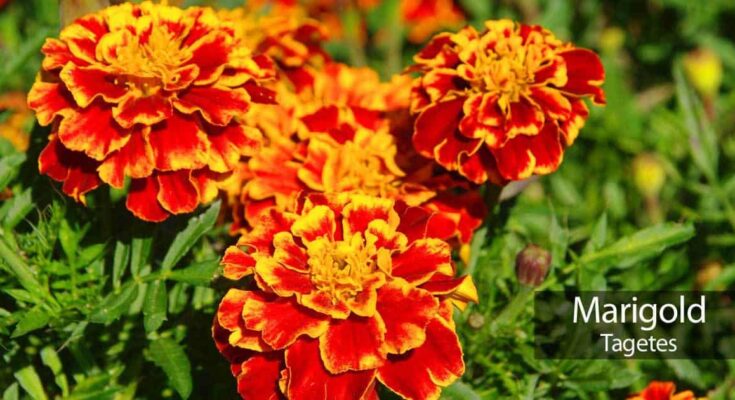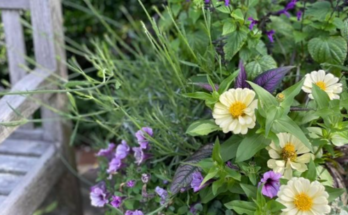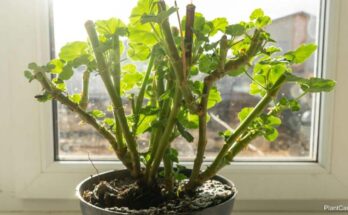Many flowers are considered garden staples. Few are as popular with all ages and indoor and outdoor growers as humble marigold flowers. Marigolds are part of the Asteraceae family, along with asters and sunflowers.
Their native range runs from the southwestern US down into South America. They are so durable that they’ve become cosmopolitan over the years.
A lot of plants bear the nickname “marigold”, all true marigolds belong to the genus Tagetes (TAG-e-teez).
There are over 50 species of marigolds, plus numerous cultivars, although the three most common species (all boasting many cultivars) are the following:
- African marigold (Tagetes erecta)
- French marigold (Tagetes patula)
- Signet marigold (Tagetes tenuifolia)
While some species make good perennials, most are grown as annuals.
Marigold Care
Size and Growth
Marigolds can vary greatly in size, with a height of 6” inches up to 4’ feet and a spread of 6” inches to 2’ feet across.
All are relatively fast growers and have a slightly pungent scent that may or may not be noticeable to humans.
This scent makes them useful in complimentary gardening as a pest-repellent plant.
Flowering and Fragrance
Marigolds will produce blooms of orange to yellow, sometimes tinged with red highlights, beginning in late spring.
These blooms will continue until the first frost, and spent heads are self-seeding if allowed to fall off on their own.
Check out this article if your Marigold plants are not flowering.
Light and Temperature
While capable of tolerating a small amount of shade, marigolds are best-suited for full sun, and the more, the merrier!
In fact, marigolds can handle more intense sun than a lot of other garden plants, and they’ll only begin to suffer in the most intense conditions.
Likewise, these hardy plants can handle a wide humidity range, although high humidity can significantly increase the risk of fungal infections.
You can plant marigolds outdoors in USDA hardiness zones 2 through 11, although perennials will only survive the winter in warmer climates.
While they can handle a bit of chill, marigolds can’t handle temperatures below 40° degrees Fahrenheit.
Indoors, average room temperatures are perfect for a healthy plant.
Caring For Marigolds: Watering and Feeding
One nice thing about Marigolds care is they are not finicky about watering, and while they need to be watered a bit more often, this is simply due to their shallow root system.
Using the finger technique, you’ll need to water when the soil feels dry ½” inch deep (halfway to your first knuckle).
For the best results, always use the soak-and-dry method, as getting the foliage wet or oversaturating the soil can lead to fungal infections.
Pour slowly enough that the soil can instantly absorb the water and work your way around the base of the plant, evenly covering the soil as you go.
Stop when the soil surface can no longer absorb as fast as you’re pouring or when you see moisture seeping from the drainage holes.
However, when it comes to fertilizing marigolds, you can ask a dozen gardeners and get a dozen answers.
However, you can follow a few basic guidelines to set your own fertilizing regimen.
Ground-based marigolds don’t require any fertilizer unless the soil is especially poor, which should be added before planting or transplanting the marigold.
When dealing with container-based marigolds, you’ll have to experiment to find what works best for you.
As a general rule, taller marigold species and cultivars do well with a balanced NPK ratio, while smaller and bushier types are best with a 1-2-1 or 1-3-2 ratio.
Liquid fertilizers are preferable and should be diluted according to the package instructions.
Application frequency can also vary widely but should be no more frequent than once per week during the growing season.
Avoid giving smaller marigolds fertilizer with high nitrogen, or they’ll focus all their energy on foliage instead of blooms.
Soil and Transplanting
When people say that marigolds are one of the easiest plants to grow, they aren’t joking.
You can grow them in just about any soil type or potting mix, although it needs to be well-draining.
They can also handle an acidic 6.0 to neutral 7.0 pH level. While they thrive in soils with a degree of organic matter, they can also survive in very poor soil – especially the African marigold.
You won’t need to report annual marigolds if you have a container with good drainage holes.
In the garden, however, you may need to transplant some marigold seedlings to spread them out if you allowed the plant to self-seed the previous year.
Grooming and Maintenance
Marigolds pretty much take care of themselves, but there are two optional things you can do to supplement their growth.
Mulching around the plants can help reduce weeds, although it can also provide shelter for insect pests.
Companion planting can often be a better alternative, as you can group plants with different root depths closer together.
Deadheading is another optional care method.
You can encourage more blooms to appear during the season by pinching off spent blooms.
However, marigolds excel at self-seeding if you let them be.
Still, deadheading will interrupt seed development, so you should only deadhead early in the blooming period (if at all) unless you want to start from seeds again next year.
NOTE: Some growers like to pinch off smaller marigold plants when young to encourage bushier growth, although this won’t have much effect on marigold plants that aren’t naturally bushy.
How To Propagate Marigolds?
Marigold seeds are easy to harvest and have a high success rate, but using them to propagate cultivars will always result in a surprise plant.
However, you can actually also propagate marigolds through stem cuttings.
This allows you to grow additional cultivars with about as much effort as growing the main species plants from seeds.
Marigold Pests or Diseases
Marigolds give off a scent that makes them deer and rabbit-resistant.
They also repel a wide range of insect pests, although spider mites and aphids are both known to infest the plant under the right conditions.
Fungal infections are the most common health issue, with powdery mildew being especially common.
While some marigolds (such as Tagetes lucida and Tagetes minuta) are edible, not all marigold species are as palatable or edible, although they’re not considered particularly toxic to humans.
Cats and dogs are different, as these plants are somewhat toxic to cats and mildly toxic to dogs.
Some species have also been known to cause contact dermatitis in sensitive individuals.
Tagetes Uses
Marigolds are the perfect starter plant for children due to how easy they are to grow from seeds and how much abuse they can take.
Depending on the species, marigolds can be used in food coloring, dyes, herbal tea, and even eaten.
When grown in pots, they look great in window boxes, hanging baskets, bookshelves, and a wide range of other places.
Best of all, marigolds are incredible companion plants, repelling many pests while attracting beneficial insects and pollinators.
More On Marigold Plant Care
Source link
Originally posted 2022-09-04 16:05:02.





